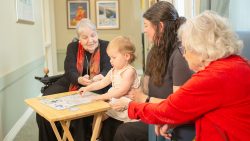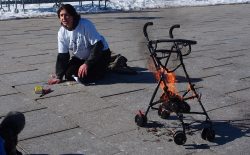Paul Bornn has seen his fair share of war machines.
From repairing heavy tankers to driving Cougar armoured vehicles across war zones in combat, the Canadian Forces veteran learned the ins and outs of war rigs and carriers over his decade of service. As a retiree he’s still tinkering with those machines, only on a smaller scale.
His basement is packed with models of vehicles, aircrafts and even spaceships.
“That was my trade,” said Bornn. “I was a weapons tech. I got into tank regiments because I wanted to work on really big guns and really big machinery.”

Bornn has regularly participated in model shows and attended conventions across the province. After years of building his own models, he became head of the Ottawa chapter for Operation VetBuild, a group that helps veterans heal through model building and social support.
“What’s good about these kinds of groups is that you can get people with non-visible injuries and have a positive influence on their life,” said Bornn. “You have a chance to share a really nourishing, positive, encouraging, uplifting experience with people.”
From childhood, Bornn always liked working with his hands.
After enlisting in 1986 at 16 — with his father’s consent — Bornn served as a reservist with the 2e Battalion of the Irish Regiment of Canada. In 1991, Master Cpl. Bornn moved to Montreal, transferring his service to the Royal Canadian Hussars, one of the oldest cavalry regiments in Canadian history.
With a war raging in former Yugoslavia, Bornn volunteered his service to Operation Cavalier, Canada’s contribution to the United Nations Protection Force in Bosnia.
For some, it’s a painful memory. Through building models, you can deal with what you’ve done. Getting involved with groups like VetBuild, it helps you reconnect with what you were.
Mark Charlton, Canadian Forces veteran
A qualified armourer and rifleman, Bornn was assigned to a 13-person maintenance troop focused on repairing weapons and military vehicles. He deployed on May 14, 1993, and his troop headed for war-torn Bosnia.
Bornn and his troop worked out of a makeshift basement workshop, repairing equipment and armored vehicles, ensuring every rifle and mounted weapon was safe and operational for their fellow gunners and servicemen.
Bornn retired in 1998, a few years after his seven-month deployment.
“A lot of us came home with a lot of issues and a lot of struggles,” said Bornn. “There was no real support offered. We were never told about the different opportunities for mental health. You were just dropped off and told, good luck and all the best.”
“That’s why I got out a few years later. I couldn’t process being in the military anymore.”
VetBuild member Mark Charlton served 32 years before retiring from the Canadian Forces in 2008.
Like Bornn, Master Warrant Officer Charlton says he knows what it was like to be dropped into the middle of a civil war.

He was in Rwanda in 1994 and he still remembers the small things. The ruts in the dirt road. The tactical markings on abandoned war tanks. The smell.
Many of these details make it onto the dioramas he creates in his spare time.
“Most veterans have a weird sense of humour,” said Charlton. “I guess that’s how we cope with stuff.”
Since serving during the Rwandan genocide, Charlton has tried to carefully recreate moments from his deployment with scale models.
“For some, it’s a painful memory,” said Charlton. “Through building models, you can deal with what you’ve done. Getting involved with groups like VetBuild, it helps you reconnect with what you were.”
Bornn reflected on his experiences in service and his model building, saying that a positive escape can make all the difference.
“Having had my own struggles coming back from Bosnia … I can very much understand and relate to others who are suffering on their own.”
Glenn Cauley, president of the Ottawa chapter of the International Plastic Modellers Society (IPMS), says model building has brought him closer to the memory of his father.

“My father was an air force veteran in World War II,” said Cauley. “He was a navigator on Lancaster bombers and he sank a German U boat.”
Cauley spent years building the aircrafts his father flew and the submarines he sunk during his time in the air force.
“Unfortunately, I never built them to my own satisfaction,” said Cauley. “But when I do, I will build it with my father’s markings. People might not see all the tiny little details, personal touches that I add. I don’t care. It’s just for me.”
Besides the personal connection, Cauley believes model building has helped keep his mind healthy.
“The more you have hobbies that involve manual stuff, whether it’s fine detail, painting, sketching, or building stuff, apparently there’s a link to reduction of mental decline staving off Alzheimer’s and things like that,” said Cauley. “If it keeps my mind active, I’m more than happy to continue doing it.”
Cauley is not far off in this belief.
A study published in the National Library of Medicine says that engaging in mentally stimulating activities, especially ones that involve social interaction, have been associated with lower risk for developing Alzheimer’s disease and other dementias.
“I did not know about this program until Paul told me about it a few years ago,” said Cauley. “I think it’s marvelous. Anything we can do to help our veterans get through the problems they have in life, I applaud wholeheartedly.”
The more you have hobbies that involve manual stuff, whether it’s fine detail, painting, sketching, or building stuff, apparently there’s a link to reduction of mental decline staving off Alzheimer’s and things like that. If it keeps my mind active, I’m more than happy to continue doing it.
Glenn Cauley, president, Ottawa chapter of International Plastic Modellers Society
Following the Canadian War Museum’s early October conference on the veteran experience, and their IPMS 2025 CAPCON showcase on Oct. 18, Bornn is looking forward to growing his VetBuild community.
“It’s also for myself too,” said Bornn. “I enjoy doing it, I enjoy going out and building the models, shooting the breeze, having a coffee.”
“When you have the opportunity to share your negative experiences and relive them in a safe, positive way, it helps make them a little less hard to stomach.”




